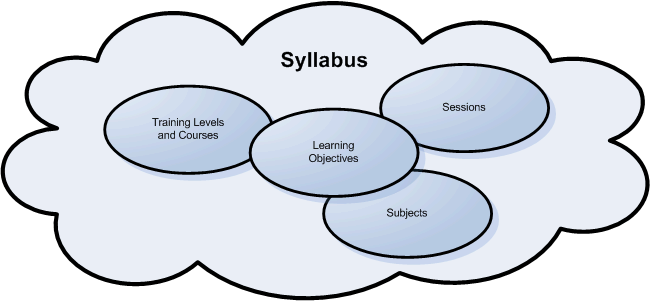Every training based organisation has a syllabus of some kind - perhaps one set by an industry standards group, government, or more often that not - by itself. If you or your team are responsible for updating an old syllabus, or even creating an entirely new one, you'll know what a headache that can be.
Read below for important pointers on how you can create a robust and comprehensive syllabus, and how ITM can make that easier for you. The good news is that you almost certainly already have the knowledge and tools at hand to create a world class result. Many of these pointers are likely to be things you already know.
The important steps to creating a syllabus are:
- Define your Training Levels
- Create your Learning Objectives
- Associate your Learning Objectives to Training Levels and Sessions
In ITM we consider the term syllabus to mean the total sum of everything that you teach or your students learn. Your organisation will therefore have one syllabus - containing hundreds or thousands of Learning Objectives (LO's) which are usually grouped into Training Levels and Courses. Some examples of Training Levels (TL's) in different types of organisations are:
- In a school - "Grade 9 French"
- IT Training company - "MS1017: Web Development with Microsoft Visual Studio"
- Rescue team - "Intermediate Technician training"
- First Aid trainer - "Basic CPR Refresher"
- Cadet Unit - "Junior NCO Course"

The conceptual heirarchy in ITM is to have one syllabus, with many Training Levels, and many LO's in those Levels. As a Training Manager, you would bring various Learning Objectives together into a Session (e.g. a lesson, exercise, or assessment) for delivery. A Session will often comprise of just LO's from one Level, but could also have LO's from other Levels. For example, a First Aid lesson might comprise of these four objectives:
- Basic Level - "Approaching a scene"
- Basic Level - "ABC's"
- Basic Level - "Beginner Rescue Breathing"
- Intermediate Level - "More Rescue Breathing"
So the main thing you will want to focus on is deciding what your Training Levels will be, and then loading all the Learning Objectives into ITM.
A Learning Objective is the smallest chunk of learning - consider each one to be a step towards the overall learning outcome.
The LO must be clearly defined, measurable, and specific. It should define what will be done from the students perspective. This approach is better aligned with the desired outcomes than if we were to state what the instructor should do - after all, the instructor is not the one who needs to learn the material.
TIP - If you already have your Learning Objectives documented outside of ITM, and there are quite a few of them, then you can contact Mission Control and we will assist you load them into our database directly - saving you the time required to type them all in.
One important feature of ITM is that each Learning Objective can be used in multiple Training Levels, just as it can be used in multiple Sessions. For example, you can 're-use' an objective from a First Aid course in an Outdoor Survival course, without having to create a new LO. One advantage to this is that improvements you make to the LO in the First Aid course are immediately available to the Survival course. Another advantage is that the Survival instructors can see which of their students have already covered certain aspects of their course, and can plan their lessons accordingly.
Once all your Training Levels and Learning Objectives have been entered into ITM, the next step is to build the Sessions that will be taught. We recommend you start small, creating the sessions for just one Course to begin with, and then as each new course comes along, prepare the Sessions for it ahead of time. Make sure you generate Lesson Allocations for your instructors so they can give you feedback on whether the design of the objectives and Session itself is valid and optimal.
Related Articles:
What is a Learning Objective?
What are Sessions?
Training Levels and Courses - what are they?